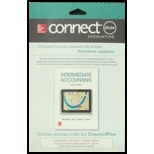
Concept explainers
1.
Retail inventory method: It takes into account all the retail amounts that is, the current selling prices. Under this method, the goods available for sale, at retail is deducted from the sales, at retail to determine the ending inventory, at retail.
Conventional Retail Method: Conventional retail method refers to the estimation of the lower of average cost or market by eliminating the markdowns from the calculation of the cost-to-retail percentage.
In this case, the cost-to-retail percentage will be determined by dividing the goods available for sale at cost by the goods available for at retail (excluding markdowns). Thus, the conventional retail method will always result in lower estimation of ending inventory when the markdowns exist.
To Calculate: The amount of ending inventory and cost of goods sold.
1.
Explanation of Solution
The following table shows the ending inventory and cost of goods sold.
| Details | Cost ($) | Retail ($) |
| Beginning inventory | 100,000 | 150,000 |
| Add: Net purchase | 1,387,500 | 2,000,000 |
| Freight-in | 10,000 | |
| Net markups | 300,000 | |
| Less: Net markdowns | (150,000) | |
| Goods available for sale | 1,497,500 | 2,300,000 |
| Less: Normal Shrinkage | (15,000) | |
| Sales to customers | (1,750,000) | |
| Sales to employees | (250,000) | |
| Employee discounts | (62,500) | |
| Estimated ending inventory at retail | 222,500 | |
| Estimated ending inventory at cost | (135,992) (1) | |
| Estimated cost of goods sold | 1,361,508 |
Table (1)
Working Note:
Calculate cost-to-retail percentage.
Calculate the amount of estimated ending inventory at cost.
Therefore, the amount of ending inventory and cost of goods sold (conventional) at cost are $222,500 and $1,361,508.
2.
Last-In, First-Out (LIFO): In Last-in-First-Out method, the costs of last purchased items are sold first. The value of the closing stock consists the initial purchased items.
To Estimate: the amount of ending inventory and cost of goods sold (LIFO).
2.
Explanation of Solution
Estimate the amount of ending inventory and cost of goods sold (LIFO).
| Details | Cost ($) | Retail ($) |
| Beginning inventory | 100,000 | 150,000 |
| Add: Net purchase | 1,387,500 | 2,000,000 |
| Freight-in | 10,000 | |
| Net markups | 300,000 | |
| Less: Net markdowns | (150,000) | |
|
Goods available for sale (excluding beginning inventory) |
1,397,500 | 2,150,000 |
|
Goods available for sale (including beginning inventory) |
1,497,500 | 2,300,000 |
| Less: Normal Shrinkage | (15,000) | |
| Sales to customers | (1,750,000) | |
| Sales to employees | (250,000) | |
| Employee discounts | (62,500) | |
| Estimated ending inventory at retail | 222,500 | |
| Estimated ending inventory at cost | (147,125) (3) | |
| Estimated cost of goods sold | 1,350,375 |
Table (2)
Working Notes:
Calculate cost-to-retail percentage:
Calculate the amount of estimated ending inventory at cost:
Therefore, the amount of ending inventory and cost of goods sold (LIFO) at cost are $222,500 and $1,350,375
Want to see more full solutions like this?
Chapter 9 Solutions
INTERMEDIATE ACCT.-CONNECT PLUS ACCESS
- Accurate answerarrow_forwardI need help with this general accounting question using standard accounting techniques.arrow_forwardCobalt Industries purchases a milling machine for $12,500. In addition, it incurs a sales tax of $600, shipping costs of $1,200, and $2,300 in labor costs to put the machine in place. The estimated residual value of the machine at the end of its useful life is $900. What is the depreciable base of the machine?arrow_forward

 AccountingAccountingISBN:9781337272094Author:WARREN, Carl S., Reeve, James M., Duchac, Jonathan E.Publisher:Cengage Learning,
AccountingAccountingISBN:9781337272094Author:WARREN, Carl S., Reeve, James M., Duchac, Jonathan E.Publisher:Cengage Learning, Accounting Information SystemsAccountingISBN:9781337619202Author:Hall, James A.Publisher:Cengage Learning,
Accounting Information SystemsAccountingISBN:9781337619202Author:Hall, James A.Publisher:Cengage Learning, Horngren's Cost Accounting: A Managerial Emphasis...AccountingISBN:9780134475585Author:Srikant M. Datar, Madhav V. RajanPublisher:PEARSON
Horngren's Cost Accounting: A Managerial Emphasis...AccountingISBN:9780134475585Author:Srikant M. Datar, Madhav V. RajanPublisher:PEARSON Intermediate AccountingAccountingISBN:9781259722660Author:J. David Spiceland, Mark W. Nelson, Wayne M ThomasPublisher:McGraw-Hill Education
Intermediate AccountingAccountingISBN:9781259722660Author:J. David Spiceland, Mark W. Nelson, Wayne M ThomasPublisher:McGraw-Hill Education Financial and Managerial AccountingAccountingISBN:9781259726705Author:John J Wild, Ken W. Shaw, Barbara Chiappetta Fundamental Accounting PrinciplesPublisher:McGraw-Hill Education
Financial and Managerial AccountingAccountingISBN:9781259726705Author:John J Wild, Ken W. Shaw, Barbara Chiappetta Fundamental Accounting PrinciplesPublisher:McGraw-Hill Education





